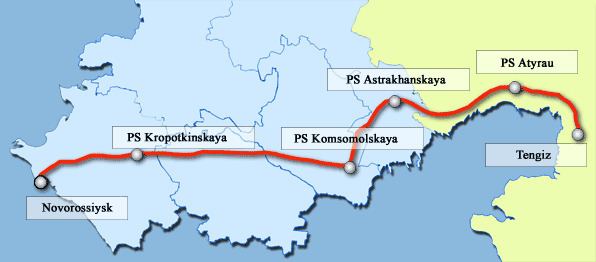Founded 1992 Commissioned 2001 | General direction east–west Operator CPC-R, CPC-K Type of business oil | |
 | ||
Partners Transneft, Government of Kazakhstan, Chevron Caspian Pipeline Consortium Co., LukArco, Mobil Caspian Pipeline Co., Rosneft - Shell Caspian Ventures Ltd., Agip International (N.A.) N.V., Oryx Caspian Pipeline LLC, BG Overseas Holdings Ltd., Kazakhstan Pipeline Ventures LLC (KazMunayGas and BP) Similar Tengizchevroil, LukArco, Transneft | ||
Oleg ivanishchev caspian pipeline consortium
The Caspian Pipeline Consortium is a consortium and a pipeline to transport Caspian oil from Tengiz field to the Novorossiysk-2 Marine Terminal on Russia's Black Sea coast. It is also a major export route for oil from the Kashagan and Karachaganak fields. As of 2009, the CPC pipeline is the only oil export pipeline in Russian territory not wholly owned by Transneft.
Contents
- Oleg ivanishchev caspian pipeline consortium
- Caspian pipeline consortium exports over 44 million tons of oil in 2016
- History
- Technical features
- Operations
- Consortium
- References
Caspian pipeline consortium exports over 44 million tons of oil in 2016
History
CPC was initially created in 1992 as a development by the Russian, Kazakhstani and Omani governments to build a dedicated pipeline from Kazakhstan to export routes in the Black Sea. Chevron Corporation was asked to join, however talks broke down due to the high financial burden Chevron would have to take on relative to equity in the pipeline. Progress on the project stalled for several years until 1996 when a restructure included eight production companies in the project. Among the companies were Chevron, Mobil, LUKoil, Royal Dutch Shell and Rosneft. BP joined the consortium in 2003. Shares were divided fifty-fifty between the three states and the eight companies. Production companies financed the construction cost of US$2.67 billion, while the Russian Federation contributed unused pipeline assets worth US$293 million. First oil was loaded onto a tanker at the Novorossiysk Marine Terminal on 13 October 2001 and the first stage of the pipeline was officially inaugurated on 27 November 2001. Regular operations started in April 2003.
In April 2007, the Russian government transferred its shares to the Russian state-owned oil pipeline company Transneft. In October 2008, the Government of Oman sold its 7%-stake to Transneft at a price of $700million and withdrew from the project. On 17 December 2008, a memorandum on expanding the pipeline was signed.
Technical features
The diameter of the 1,510 kilometres (940 mi) long oil pipeline varies between 1,016 millimetres (40.0 in) and 1,067 millimetres (42.0 in). There are five pumping stations. The marine terminal includes two single point moorings and the tank farm consists of four steel storage tanks of 100,000 cubic metres (3,500,000 cu ft) each. Pipeline throughflow started at 350,000 barrels per day (56,000 m3/d) and has since increased to 700,000 barrels per day (110,000 m3/d).
An envisaged second stage will add 10 pumping stations for a total of 15. The number of tanks will increase to ten and one more mooring will be constructed. Capacity will increase to 1.3 million barrels per day (210,000 m3/d). The second stage has been estimated to cost around US$2 billion and will be completed by 2012.
Operations
In 2008, CPC transported 31.5 million tons of crude, down from 32.6 million tonnes in 2007. In the first three months of 2009, the pipeline transported 8.7 million tonnes of oil.
Consortium
The Caspian Pipeline Consortium was initially registered in the Bermuda Islands in 1992. It is split into two companies: CPC-R operates the Russian section of the pipeline and CPC-K operates the Kazakh section.
The shareholders of the consortium are:
Tengiz Field shareholders control 55.75% of the Consortium, Kasaghan shareholders control 33.1%.
In December 2009, BP sold its stake in LukArco to Lukoil for $1.6 billion.
